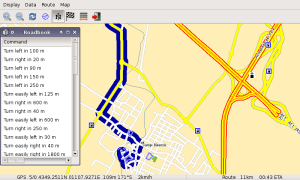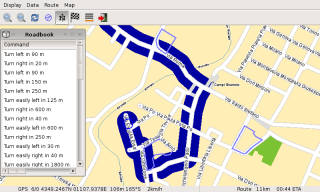This is an old revision of the document!
Table of Contents
Installing Navit on the EeePC
Navit is a car navigation system with routing engine. As it is free software, it runs on Linux, it can use the maps from OpenStreetMap, I definitivelly want to give it a try.
Obviously the platform of choice was the new Asus EeePC, where I installed a shining Debian Testing (Lenny).
Compiling and installing Navit with Debian
 The package entered Debian Squeeze.
The package entered Debian Squeeze.
At present (2009-11) you can easily backport it to Debian Lenny, just download the three file .dsc, .orig.tar.gz and .diff.gz from the Debian site and do:
dpkg-source -x navit_0.2.0~svn2663+dfsg.1-1.dsc cd navit-0.2.0~svn2663+dfsg.1 dpkg-buildpackage -rfakeroot
… obviusly all the build dependencies must be installed before. The results are seven .deb packages that you can install with dpkg -i.
Getting the map from OpenStreetMap
It is possible to load the map of entire Italy. I downloaded italy.osm.bz2 from download.geofabrik.de; converting the file into Navit format I got a 4.7 Mb file:
bzcat italy.osm.bz2 | osm2navit /usr/local/share/navit/maps/italy.bin
I had to tell Navit to load this map editing the file /usr/local/share/navit/navit.xml, adding a mapset section:
<mapset enabled="yes"> <map type="binfile" enabled="yes" data="/usr/local/share/navit/maps/italy.bin" /> </mapset>
Installing the GPS daemon
Before starting Navit the gpsd should be up and running. Install the gpsd package and configure it, this is the relevant part of /etc/default/gpsd file:
START_DAEMON="true" DAEMON_OPTS="" DEVICES="/dev/gps0" USBAUTO="true"
It is convenient to let udev handle some operations: when I connect my i-Blue 747 USB GPS logger I want gpsd to be started (if it was not). Just add the following line to the file /etc/udev/rules.d/z60_gpsd.rules and restart udev:
# i-Blue 747 USB GPS datalogger
SYSFS{idVendor}=="10c4", SYSFS{idProduct}=="ea60", SYMLINK="gps%n", RUN+="/lib/udev/gpsd.hotplug.wrapper"
When the GPS is plugged into the USB port, udev creates the /dev/gps0 device and starts gpsd. When the GPS is unplugged the Unix device is removed, but the daemon remains running.
A simple test to check that gpsd is working, is to run gpspipe -r (provided by the gpsd-clients package), it should print out the NMEA messages recevied from the GPS:
gpspipe -r GPSD,R=1 $GPGGA,112813.000,4353.5310,N,01106.1005,E,0,3,,102.4,M,47.6,M,,*4E $GPGSA,A,1,,,,,,,,,,,,,,,*1E $GPGSV,2,1,08,20,76,331,39,11,64,162,30,23,54,197,31,17,37,288,16*74 $GPGSV,2,2,08,31,25,070,25,32,18,072,27,13,16,209,24,04,05,308,*7E $GPRMC,112813.000,V,4353.5310,N,01106.1005,E,0.08,349.33,040408,,,N*74 $PMTK001,-1,0*1F $PMTK001,-1,0*1F $GPGGA,112814.000,4353.5310,N,01106.0969,E,0,3,,102.4,M,47.6,M,,*4B
Problems to be solved with gpsd
We want to be able to plug/unplug the GPS device in the USB port and gpsd should work seamless, but there are two problems:
- Permissions: if gpsd starts with no GPS is connected, it switches to group nobody. When a GPS is connected, udev add the /dev/ttyUSB device as root:dialout and /lib/udev/gpsd.hotplug assigns mode 0660. In this scenario gpsd cannot read the device.
- GPS unplug/plug: when a gps client opens a connection with gpsd, it starts receiving data. If GPS device is unplugged and plugged again, the connection does not restart automatically. A workaround is to execute
gpspipe -r n1to force device re-opening.
A workaround at the first problem is to let /etc/init.d/udev create a node for /dev/ttyS0 at boot time, even if no devices are present. Per default gpsd will read the group of this device and switches to that group.
mknod -m 0660 /lib/udev/devices c 4 64 chown root:dialout /lib/udev/devices
For the second problem I hacked /lib/udev/gpsd.hotplug, adding the execution of a script when the device is re-added:
if action == 'add': # Force the group-read & group-write bits on, so gpsd will still be # able to use this device after dropping root privileges. os.chmod(argument, stat.S_IMODE(os.stat(argument)[stat.ST_MODE])|0660) connect.sendall("+%s\r\n" % argument) connect.recv(12) os.system('/usr/local/bin/gps-reopen')
The script is simple this:
#!/bin/sh /bin/echo /usr/bin/gpspipe -r -n1 | /usr/bin/at now
Don't ask me why I need running gpspipe it via at, I suspect there is the need of a controlling terminal, etc…
Navigation
 I did not tried it extensively, but I was quite impressed: the EeePC's screen size (800×480) is acceptable, panning and zooming are quick.
I did not tried it extensively, but I was quite impressed: the EeePC's screen size (800×480) is acceptable, panning and zooming are quick.
Turn-by-turn routing is working: point the map, right-click and Set as destination!
Speech
You can have turn-by-turn speech indications by installing the speech-dispatcher-festival package. It will install the speech daemon plus the festival speech synthesis system. I installed also the Italian voice module. This is the list of Debian Lenny packages:
- speech-dispatcher-festival
- festvox-kallpc8k
- festvox-italp16k
- festvox-itapc16k
To verify that your text-to-speech system is working, try this:
echo "Ti ho nel cuore ma ti vò nel culo" | iconv -f UTF-8 -t ISO-8859-1 | festival --language italian --tts
To let Navit use text to speech, add the following line in navit.xml config file:
<speech type="cmdline" data="echo '%s' | festival --tts --language italian" />
If Italian is not your default locale, you can start Navit just after setting it:
export LANG=it_IT.UTF-8 navit
